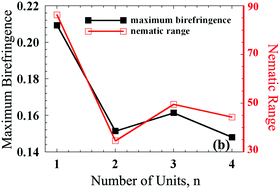Oligomeric odd–even effect in liquid crystals
Abstract
Odd–even effects, oscillations in properties of materials comprised of an odd or even number of connected repeating units, are well-known phenomena in materials science. In organic materials, they are usually associated with the number of methylene groups in aliphatic chains. In this work, we unveil multiple signatures of a new odd–even effect in liquid crystals that occurs at the larger scale of molecular moieties that by themselves express liquid crystalline behavior. We demonstrate that oligomeric liquid crystals, with n = 1–4 number of rigid mesogenic segments connected by flexible aliphatic chains with an odd number of methylene groups, produce an odd–even effect in optical anisotropy and the bend elastic constant of the liquid crystal oligomer. This effect is different from the usual odd–even effects with respect to the parity of carbon atoms in an aliphatic chain and can be understood in term of the average molecular shape and the associations between n-mers based on the packing of these shapes. We also show that, in spite of the fact that there is no long-range electron density modulation, careful analysis of synchrotron SAXS results can provide important information about the molecular associations in the N and NTB phases that other techniques cannot access. This novel odd–even effect opens up a new mode to optimize phase and optical behavior.

- This article is part of the themed collection: 2019 Materials Horizons Most Popular Articles


 Please wait while we load your content...
Please wait while we load your content...